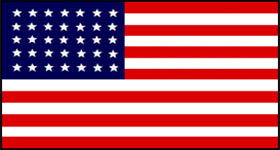Civil War Battles |
Colonial Wars |
American Wars |
Link To This Page — Contact Us —
The Battle of Dove Creek
January 9, 1865 in Dove Creek, Texas
 |
|||||||||||||||||||||
|
DOVE CREEK, BATTLE OF. In the controversial battle of Dove Creek on January 8, 1865, about 160 Confederates and 325 state militiamen attacked a large encampment of migrating Kickapoo Indians some twenty miles southwest of the site of present San Angelo. The Texans were routed after a desperate fight. On December 9, 1864, Capt. N. M. Gillintine (Gillentine) and a militia scouting party of twenty-three, under command of the Second Frontier District, discovered an abandoned Indian camp. Gillintine reported that it had ninety-two wigwam sites and was located about thirty miles up the Clear Fork of the Brazos River from the ruins of old Fort Phantom Hill. A militia force of about 325 men from Bosque, Comanche, Coryell, Erath, and Johnson counties gathered under Capt. S. S. Totten (Totton). State Confederate troops of the Frontier Battalion were dispatched under Capt. Henry Fossett.
From the beginning the two forces neglected to cooperate fully or agree upon a unified command. After waiting two days at Fort Chadbourne for a rendezvous that never took place, Fossett impatiently set out on January 3 with 161 men and followed a broad trail to the North Concho River and beyond. Four days later his scouts found the Indians, whom they assumed to be hostile Comanches or Kiowas, encamped in timber along Dove Creek. As Fossett prepared to strike, Totten's delayed militia arrived early in the morning of January 8. Some historians have argued that by then the leader should have realized that the Indians were peaceful. Operating on the frontier assumption that all Indians were dangerous, however, the two commanders hastily formed a battle plan that was afterward criticized as inadequate and based on poor reconnaissance. The militia, on horses weary from a forced march, were to dismount and wade the creek for a frontal attack from the north. The Confederate troops were to circle southwestward, capture the grazing herd of horses, and attack from the lower side, thus cutting off an Indian retreat.
The attack went badly. Fossett later estimated the Indian fighting force at between 400 and 600. Totten said 600 and charged that Union jayhawkers were among them. The Indians' position in a heavy thicket was superior, for it gave the well-armed defenders cover, high ground, and a good field of fire. The militiamen were slowed by the creek, heavy briars, and brush. Participant I. D. Ferguson later recounted the fatal wounding of three officers, including Gillintine, and sixteen enlisted men in the opening minutes. The militia was soon routed and out of the battle.
Meanwhile, Fossett's mounted force quickly captured the Indian horses. He dispatched seventy-five troops under Lt. J. A. Brooks to hit the camp from the south, but they were repulsed by heavy fire that cost them twelve horses. The Confederate troops took positions in the timber and continued the fight; they were caught in a crossfire and separated into three groups as the Indians closed in under cover. An Indian counterattack early in the afternoon was repulsed, and the battle continued until almost dark before ending in disorder and confusion. The Indians recaptured their horses and inflicted additional casualties on the Confederates retreating toward Totten's militia, which was tending to the wounded three miles away on Spring Creek. The battered veterans spent a miserable night, drenched by chilling rain that turned to heavy snow. They remained the next day, cold and hungry, forced to eat some of the horses in order to survive. A casualty count showed twenty-two dead and nineteen wounded. An exact number was never known because many militiamen departed without leave.
Indian casualties were even less certain. Totten said they numbered more than a hundred. Fossett gave a body count of twenty-three. The Indians, after crossing the Rio Grande near Eagle Pass, said they had lost twelve in the fight and two more who died after arrival in Mexico.
Carrying their wounded on crude litters strapped between pairs of horses, the Texans retreated eastward on January 11, after retrieving their dead. They found shelter and food at John S. Chisum'sqv ranch near the confluence of the Concho and the Colorado rivers.
The Kickapoos had been on their way to Mexico to escape the dissension and violence of the Civil War.qv The battle embittered this peaceful tribe and led to vengeful border raiding from the sanctuary given them by the Mexican government near Santa Rosa, Coahuila. White settlers along the Rio Grande paid heavily for the misjudgments that led to the Texans' defeat on Dove Creek. Col. Ranald S. Mackenzieqv finally led 377 men of the Fourth United States Cavalryqv from Fort Clark on a punitive expedition across the Rio Grande in May 1873. Hostilities declined thereafter.
